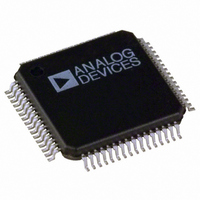ADE7569ASTZF16-RL Analog Devices Inc, ADE7569ASTZF16-RL Datasheet - Page 129

ADE7569ASTZF16-RL
Manufacturer Part Number
ADE7569ASTZF16-RL
Description
IC,Power Metering,QFP,64PIN,PLASTIC
Manufacturer
Analog Devices Inc
Specifications of ADE7569ASTZF16-RL
Applications
Energy Measurement
Core Processor
8052
Program Memory Type
FLASH (16 kB)
Controller Series
ADE75xx
Ram Size
512 x 8
Interface
I²C, SPI, UART
Number Of I /o
20
Voltage - Supply
3.135 V ~ 3.465 V
Operating Temperature
-40°C ~ 85°C
Mounting Type
Surface Mount
Package / Case
64-LQFP
Lead Free Status / RoHS Status
Lead free / RoHS Compliant
Available stocks
Company
Part Number
Manufacturer
Quantity
Price
Company:
Part Number:
ADE7569ASTZF16-RL
Manufacturer:
Analog Devices Inc
Quantity:
10 000
Preliminary Technical Data
I/O PORTS
PARALLEL I/O
The ADE7566/ADE7569 use three input/output ports to
exchange data with external devices. In addition to performing
general-purpose I/O, some are capable of driving an LCD or
performing alternate functions for the peripherals available on-
chip. In general, when a peripheral is enabled, the pins
associated with it cannot be used as a general-purpose I/O. The
I/O port can be configured through the SFRs in Table 145.
Table 145. I/O Port SFRs
SFR
P0
P1
P2
EPCFG
PINMAP0
PINMAP1
PINMAP2
The three bidirectional I/O ports have internal pull-ups that can
be enabled or disabled individually for each pin. The internal
pull-ups are enabled by default. Disabling an internal pull-up
causes a pin to become open-drain. Weak internal pull-ups are
configured through the PINMAPx SFRs.
Figure 101 shows a typical bit latch and I/O buffer for an I/O
pin. The bit latch (one bit in the each port’s SFR) is represented
as a Type D flip-flop, which clocks in a value from the internal
bus in response to a write-to-latch signal from the CPU. The
Q output of the flip-flop is placed on the internal bus in response
to a read-latch signal from the CPU. The level of the port pin
itself is placed on the internal bus in response to a read pin
signal from the CPU. Some instructions that read a port activate
the read latch signal, and others activate the read pin signal. See
the Read-Modify-Write Instructions section for details.
INTERNAL
TO LATCH
LATCH
WRITE
READ
READ
BUS
PIN
Address
0x80
0x90
0xA0
0x9F
0xB2
0xB3
0xB4
Figure 101. Port 0 Bit Latch and I/O Buffer
LATCH
CL
D
Q
Q
Bit
Addressable
Yes
Yes
Yes
No
No
No
No
ALTERNATE
ALTERNATE
FUNCTION
FUNCTION
OUTPUT
INPUT
DV
DD
Description
Port 0 Register.
Port 1 Register.
Port 2 Register.
Extended Port
Configuration.
Port 0 Weak
Pull-Up Enable.
Port 1 Weak
Pull-Up Enable.
Port 2 Weak
Pull-Up Enable.
CLOSED: PINMAPx.x = 0
OPEN: PINMAPx.x = 1
INTERNAL
PULL-UP
Px.x
PIN
Rev. PrA | Page 129 of 136
Weak Internal Pull-Ups Enabled
A pin with weak internal pull-up enabled is used as an input by
writing a 1 to the pin. The pin is pulled high by the internal pull-
ups, and the pin is read using the circuitry shown in Figure 101.
If the pin is driven low externally, it sources current because of
the internal pull-ups.
A pin with internal pull-up enabled is used as an output by
writing a 1 or a 0 to the pin to control the level of the output. If
a 0 is written to the pin, it drives a logic low output voltage
(V
Open Drain (Weak Internal Pull-Ups Disabled)
When the weak internal pull-up on a pin is disabled, the pin
becomes open-drain. Use this open-drain pin as a high impedance
input by writing a 1 to the pin. The pin is read using the circuitry
shown in Figure 101. The open drain option is preferable for
inputs because it draws less current than the internal pull-ups
that were enabled.
To use an open-drain pin as a general-purpose output, an external
pull-up resistor is required. Open drain outputs are convenient
for changing the voltage to a logic high. The ADE7566/ADE7569
are 3.3 V devices, so an external resistor pulled up to 5 V may
ease interfacing to a 5 V IC, although most 5 V ICs are tolerant
of 3.3 V inputs. Pins with 0s written to them drive a logic low
output voltage (V
38 kHz Modulation
Every ADE7566/ADE7569 provides a 38 kHz modulation
signal. The 38 kHz modulation is accomplished by internally
XOR’ing the level written to the I/O pin with a 38 kHz square
wave. Then, when a 0 is written to the I/O pin, it is modulated
as shown in Figure 102.
Uses for this 38 kHz modulation include IR modulation of
a UART transmit signal or a low power signal to drive an
LED. The modulation can be enabled or disabled with the
MOD38EN bit in the CFG SFR. The 38 kHz modulation is
available on 8 pins, selected by the MOD38[7:0] bits in the
Extended Port Configuration SFR (EPCFG, 0x9F).
OL
38kHz MODULATION
) and is capable of sinking TBD mA.
LEVEL WRITTEN
OUTPUT AT
MOD38 PIN
TO MOD38
SIGNAL
OL
) and are capable of sinking 1.6 mA.
Figure 102. 38 kHz Modulation
ADE7566/ADE7569













